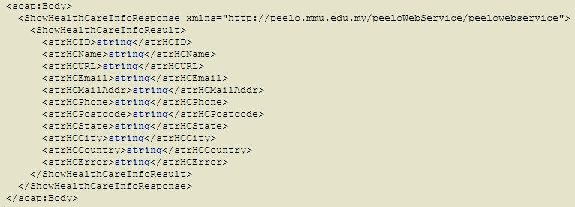


FYP Final Report v1.0.0
Copyright and All Rights Reserved To: Pee-Lo Team @2003/04
29
Snippet 3: SOAP Envelope and Headers
Next comes the SOAP headers which is actually shows the sender (or the provider) of the SOAP
message. There are two types of headers; the HTTP SOAP Headers and the SOAP Header. The
HTTP SOAP Headers are the first five lines shown in Snippet 3. It contains the information on how
to retrieve and send SOAP messages across the network. It also provides some information about
the nature of the SOAP message like how the sender’s address on an envelope reveals the identity
of the sender.
The other one is simply known as SOAP Header and this header is customizable. This header is
used to convey any additional information that is not included in the body of the message or the
HTTP SOAP Headers. This information is usually developer defined information like SOAP
message authentication information and such. SOAP Header (not to be confused with HTTP
SOAP Headers) is like some minor but crucial information printed by the sender on the envelope or
the post office which is not relevant to the receiver. An analogy will be the stamp affixed on the
envelope.
The final item will be the SOAP Body. It contains XML message that we wanted to relay to the
other party. SOAP body is enclosed in the <SOAP:Body>…</SOAP:Body> XML tag.
Within it contains all the information required for two parties to communicate. This information is
represented in XML as shown in Snippet 4.
Snippet 4: SOAP Body
POST /peeloWebService/peelowebservice.asmx HTTP/1.1
Host: localhost
Content-Type: text/xml; charset=utf-8
Content-Length: length
<?xml version="1.0" encoding="utf-8"?>
<soap:Envelope xmlns:xsi="http://www.w3.org/2001/XMLSchema-instance"
xmlns:xsd="http://www.w3.org/2001/XMLSchema" xmlns:soap="">http://schemas.xmlsoap.org/soap/envelope/">
<soap:Body>
<SearchPhysicianID xmlns="">http://peelo.mmu.edu.my/peeloWebService/peelowebservice">
<strPhysicianID>string</strPhysicianID>
</SearchPhysicianID>
</soap:Body>
</soap:Envelope>

